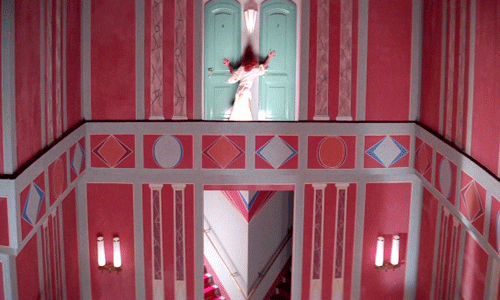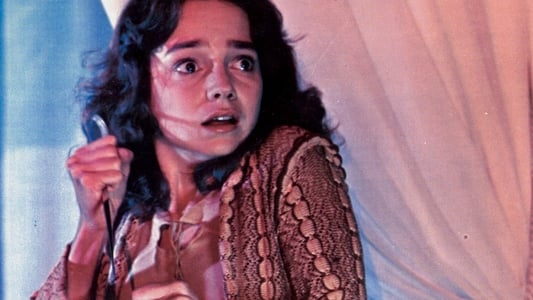Demonic voices are dangerously hissing at us as Susie is walking towards the airport’s exit doors. As soon as she leaves the safe space, she enters wind, storm and torrential rain. The voices are overshadowing her chat with the cab driver. Bright green and red lights flicker over her face. The final destination is a ballet school; a red and gold painted building, resembling a far eastern temple rather than a german institution. A panicked young woman is standing at the door, she appears to be out of her mind and yelling something into the night before she frantically runs away. They won’t let Susie in and force her to stay elsewhere. Clearly, she is not supposed to be anywhere near that town let alone enter that ballet school. The same night, a spectacular killing occurs. A virgin like figure dressed in a white nightgown, covered in blood as red as the walls surrounding her ends up hanging from the ceiling after a graphical stabbing in close up. And this is only the beginning.
A spectacle of Art Deco and beauty
Suspiria is a spectacle from start to finish. A celebration of femininity, beauty, art and sounds, wrapped up in some gory splatter here and there, all while we bask in its colourful glory, deafened by bloodcurdling screaming. Argento has created a horror extravaganza that does not lack any suspense despite its stylised visuals. The robotic acting and dubbed over voices can seem off-putting at first but it only adds to its artificiality, thus alerting the viewer even more that something eerie is going on. Throughout the film, we don’t know what we are fearing, fighting or running away from.

Watch Suspiria (1977) on Mubi
The overbearing emotionality and erratic behaviour are intensified by the dubbed voices. At first, it can seem slightly off-putting but it only adds to its mysticism and blends in with the girls’ behaviour.
The rooms display an eclectic mix of furniture and wall painting. The interior design is a mashup of Art Deco and Art Nouveau, adorned by Mondrian style mirror frames, everything is lit in saturated blues and reds. The girls’ personal spaces are drenched in blue light, which can be seen as a symbol of temporary serenity before the reds take over, luring them out of their safety into danger. Out there is no such structure and the colours get swapped, tricking the girls that the blue is safe only for them to fall into a deadly trap. The entire production design is set out to emphasise primary colours, particularly red without any other hues, rendering it more cartoonish and it’s therefore adding to the film’s nightmarish qualities. If you’re a fan of David Lachapelle’s photography, you will love Suspiria.
Costumes & make up
Hair and makeup seem to be the only constant that helps determine the time in which the movie is set. Costumes however differ from feminine 70s dresses to 20s glittery accessories such as shoes and sparkling scarfs, alongside surprisingly conservative but colourful swimming suits and black ballet attire.
The fashionable glossiness is just as much a leitmotiv as is its splatter genre. Ahead of its time, Suspiria is one of the most striking and shocking horror movies as it is a feast for the eyes and ears. Even if you can manage to forget the free-flowing blood, colours or overall design, the haunting soundtrack will keep ringing in your ears way after you leave the theatre.
You can find the production credits here.
